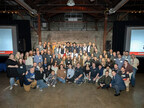NEW YORK, June 11, 2024 /PRNewswire/ — The global edge computing market size is estimated to grow by USD 19.59 billion from 2024-2028, according to Technavio. The market is estimated to grow at a CAGR of over 33.57% during the forecast period. Rising demand for decentralized computing to reduce latency in decision making is driving market growth, with a trend towards deployment of industry 4.0 infrastructure. However, competition from low-cost centralized and general-purpose computing infrastructure poses a challenge. Key market players include Aarna Networks Inc., Alphabet Inc., Amazon.com Inc., Arrow Electronics Inc., Capgemini Service SAS, Cisco Systems Inc., ClearBlade Inc., Dell Technologies Inc., EdgeConneX Inc., General Electric Co., Hewlett Packard Enterprise Co., Huawei Investment and Holding Co. Ltd., Intel Corp., International Business Machines Corp., Microsoft Corp., Nokia Corp., NVIDIA Corp., Renesas Electronics Corp., Schneider Electric SE, and Telefonaktiebolaget LM Ericsson.
Get a detailed analysis on regions, market segments, customer landscape, and companies- View the snapshot of this report
Edge Computing Market Scope
Report Coverage
Details
Base year
2023
Historic period
2018 – 2022
Forecast period
2024-2028
Growth momentum & CAGR
Accelerate at a CAGR of 33.57%
Market growth 2024-2028
USD 19597 million
Market structure
Fragmented
YoY growth 2022-2023 (%)
25.24
Regional analysis
North America, Europe, APAC, South America, and Middle East and Africa
Performing market contribution
North America at 43%
Key countries
US, China, Germany, UK, and Japan
Key companies profiled
Aarna Networks Inc., Alphabet Inc., Amazon.com Inc., Arrow Electronics Inc., Capgemini Service SAS, Cisco Systems Inc., ClearBlade Inc., Dell Technologies Inc., EdgeConneX Inc., General Electric Co., Hewlett Packard Enterprise Co., Huawei Investment and Holding Co. Ltd., Intel Corp., International Business Machines Corp., Microsoft Corp., Nokia Corp., NVIDIA Corp., Renesas Electronics Corp., Schneider Electric SE, and Telefonaktiebolaget LM Ericsson
Market Driver
The Edge Computing Market is experiencing notable growth due to the increasing adoption of Industry 4.0 practices in manufacturing. With the implementation of Industry 4.0 principles such as machine interconnection, big data collection, and decentralization, there is a heightened demand for real-time data analysis in the immediate manufacturing environment. Edge computing plays a crucial role in this process by enabling the analysis and implementation of data generated by IoT sensors, actuators, and communication tools, thereby enhancing production efficiency and reducing downtime.
The Edge Computing market is experiencing significant growth, with companies focusing on implementing technologies like 5G and Virtual Reality for faster data processing. The demand for real-time analytics and the need to reduce latency have led to the adoption of edge computing in various industries, including manufacturing and healthcare.
The use of cloud and on-premises solutions in conjunction with edge computing is also gaining popularity. Additionally, the integration of artificial intelligence and machine learning algorithms is enhancing the capabilities of edge computing systems. The market is expected to continue growing as more businesses seek to improve their operational efficiency and enhance their customer experience.
Research report provides comprehensive data on impact of trend. For more details- Download a Sample Report
Market Challenges
The global edge computing market faces challenges from the prevalence of cloud computing and its affordable pay-as-you-go services. Setting up edge computing infrastructure necessitates additional capital spending, network infrastructure, and skilled labor. Achieving service quality under service level agreements may be difficult in edge computing environments. Network nodes like access points and base stations can be utilized for edge computing, but this may require software solutions and shift focus from applications to infrastructure management.The Edge Computing market is experiencing significant growth due to the increasing demand for real-time data processing and reduced latency. However, there are challenges that need to be addressed. One major challenge is the complexity of implementing and managing edge computing infrastructure.Another challenge is ensuring security and data privacy in edge computing environments. Additionally, interoperability between different edge computing platforms and devices is a concern. Furthermore, the cost of deploying and maintaining edge computing infrastructure can be high. To address these challenges, companies are focusing on developing user-friendly solutions, enhancing security features, and collaborating to create interoperable edge computing ecosystems.
For more insights on driver and challenges – Request a sample report!
Segment Overview
End-user 1.1 Industrial manufacturing1.2 Telecom1.3 Mobility1.4 Government1.5 OthersComponent 2.1 Hardware2.2 Software2.3 Services2.4 Edge-managed platformsGeography 3.1 North America3.2 Europe3.3 APAC3.4 South America3.5 Middle East and Africa
1.1 Industrial manufacturing- Edge computing is a business solution that brings data processing closer to the source, reducing latency and bandwidth usage. It enables real-time analysis and decision-making in industries like IoT, manufacturing, and healthcare. Companies benefit from improved operational efficiency and enhanced customer experience. Edge computing is a strategic investment for businesses seeking to leverage data in a cost-effective and agile manner.
For more information on market segmentation with geographical analysis including forecast (2024-2028) and historic data (2017-2021) – Download a Sample Report
Research Analysis
The Edge Computing Market is experiencing significant growth in various industries, including IT infrastructure, telecom firms, and healthcare systems. With the increasing adoption of 5G technology, the need for traffic distribution and service management through edge computing has become crucial. This technology enables real-time processing of data from connected devices, enhancing the performance of applications such as video conferencing software, AI edge computing, and game streaming. Moreover, edge computing plays a vital role in digital health strategies, IoT in healthcare, and life sciences applications.
The integration of artificial intelligence and compliance standards in edge computing further strengthens its position in the market. Cloud computing and Industry 4.0, including smart factories and smart grids, also benefit from edge computing’s capabilities. Despite the economic recession, digital developments continue to drive the demand for edge computing. Network functions like CDNs and security solutions are essential components of edge computing, ensuring efficient traffic distribution and data protection. Additionally, augmented reality (AR) and virtual reality (VR) tools are expected to find increased applications in edge computing, further expanding its market potential.
Market Research Overview
Edge computing refers to the decentralization of data processing and analysis from cloud servers to the edge of the network, closer to the source of data. This approach aims to reduce latency, improve response times, and enhance data security. The edge computing market is experiencing significant growth due to the increasing adoption of IoT devices, the surge in data generated at the edge, and the need for real-time data processing.
The market is segmented based on components, applications, industries, and regions. The components market includes hardware, software, and services. The applications market is categorized into video processing, augmented reality, autonomous vehicles, and industrial automation, among others. Industries covered include healthcare, manufacturing, energy, and telecommunications, among others. The market is expected to grow at a robust pace in the coming years.
Table of Contents:
1 Executive Summary
2 Market Landscape
3 Market Sizing
4 Historic Market Size
5 Five Forces Analysis
6 Market Segmentation
End-userIndustrial ManufacturingTelecomMobilityGovernmentOthersComponentHardwareSoftwareServicesEdge-managed PlatformsGeographyNorth AmericaEuropeAPACSouth AmericaMiddle East And Africa
7 Customer Landscape
8 Geographic Landscape
9 Drivers, Challenges, and Trends
10 Company Landscape
11 Company Analysis
12 Appendix
About Technavio
Technavio is a leading global technology research and advisory company. Their research and analysis focuses on emerging market trends and provides actionable insights to help businesses identify market opportunities and develop effective strategies to optimize their market positions.
With over 500 specialized analysts, Technavio’s report library consists of more than 17,000 reports and counting, covering 800 technologies, spanning across 50 countries. Their client base consists of enterprises of all sizes, including more than 100 Fortune 500 companies. This growing client base relies on Technavio’s comprehensive coverage, extensive research, and actionable market insights to identify opportunities in existing and potential markets and assess their competitive positions within changing market scenarios.
Contacts
Technavio Research
Jesse Maida
Media & Marketing Executive
US: +1 844 364 1100
UK: +44 203 893 3200
Email: media@technavio.com
Website: www.technavio.com/
View original content to download multimedia:https://www.prnewswire.com/news-releases/edge-computing-market-size-is-set-to-grow-by-usd-19-59-billion-from-2024-2028–rising-demand-for-decentralized-computing-to-reduce-latency-in-decision-making-boost-the-market-technavio-302168086.html
SOURCE Technavio


 Near Videos5 days ago
Near Videos5 days ago
 Technology4 days ago
Technology4 days ago
 Technology5 days ago
Technology5 days ago
 Technology4 days ago
Technology4 days ago









